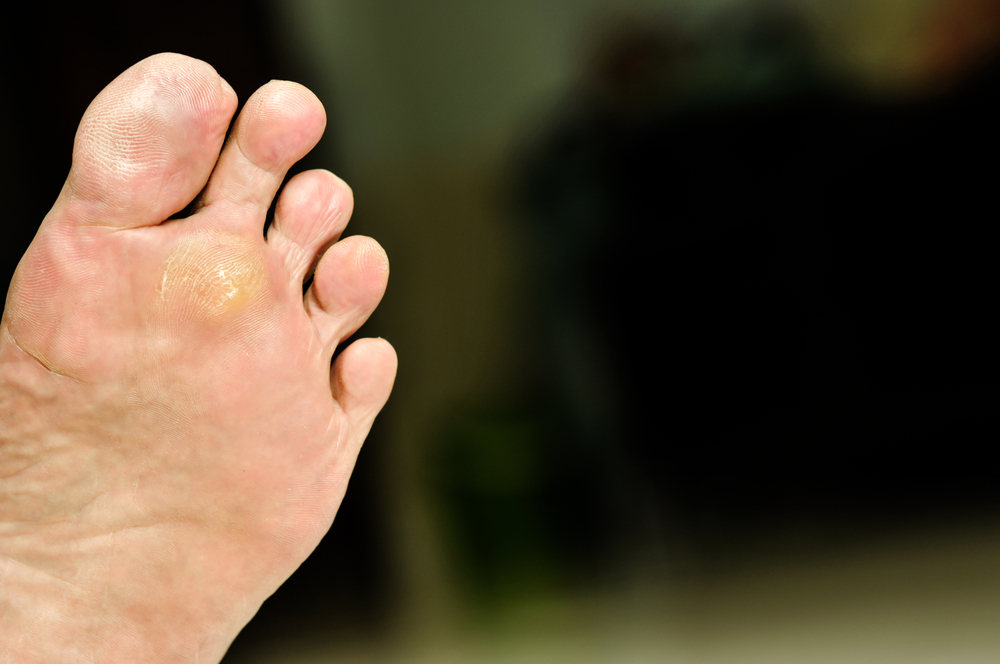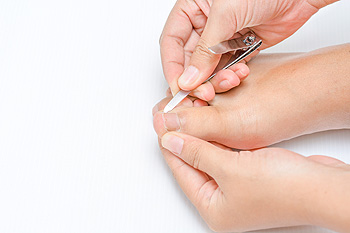
A wart is a growth on the skin caused by over 100 types of the human papillomavirus (HPV). The virus causes a thickening of the top skin layer. Plantar warts occur on the soles of the feet. These can look and feel like calluses. Anyone can get warts, but children aged 12 to 16 and those who have HIV, organ transplants, or are on chemotherapy are at the highest risk for them. Warts are often acquired from a person that has the virus. While not highly contagious, the virus can enter the skin through small cuts or cracks. It is suggested that towels and other intimate objects not be shared, and shoes be worn in public places. Warts are typically harmless and painless, but plantar warts might feel tender when walked on. These warts can be small, or they can grow to cover most of the sole of the foot. They often go away on their own, but this can take up to two years. If your teen has a plantar wart that is bothersome or interferes with their normal daily activities, please consult a podiatrist for treatment options.
Plantar warts can be very uncomfortable. If you need your feet checked, contact Dr. Lubrina Bryant from District Podiatry, PLLC. Our doctor will assist you with all of your foot and ankle needs.
About Plantar Warts
Plantar warts are the result of HPV, or human papillomavirus, getting into open wounds on the feet. They are mostly found on the heels or balls of the feet.
While plantar warts are generally harmless, those experiencing excessive pain or those suffering from diabetes or a compromised immune system require immediate medical care. Plantar warts are easily diagnosed, usually through scraping off a bit of rough skin or by getting a biopsy.
Symptoms
Treatment
To help prevent developing plantar warts, avoid walking barefoot over abrasive surfaces that can cause cuts or wounds for HPV to get into. Avoiding direct contact with other warts, as well as not picking or rubbing existing warts, can help prevent the further spread of plantar warts. However, if you think you have developed plantar warts, speak to your podiatrist. He or she can diagnose the warts on your feet and recommend the appropriate treatment options.
If you have any questions please feel free to contact our office located in Washington, D.C . We offer the newest diagnostic and treatment technologies for all your foot and ankle needs.

When the human body builds up too much uric acid, gout can occur. Gout is a type of inflammatory arthritis which often begins in the big toe and can spread across the entire foot. Often gout can come on in the form of an attack. With inflammation and damage, severe pain and swelling can occur, range of motion can be negatively impacted, and the distance and direction of joint movement can decrease. This can make it hard to walk or even put shoes on. A person can incur permanent damage from gout where the joints do not fully function. There is currently not a cure for gout, but symptoms can be alleviated or at least managed if proper help is sought. If you are experiencing pain in your big toe and you suspect you have gout, or you are not sure what the pain is from, seek the advice of a podiatrist who can diagnose the condition and provide proper treatment.
Gout is a foot condition that requires certain treatment and care. If you are seeking treatment, contact Dr. Lubrina Bryant from District Podiatry, PLLC. Our doctor will treat your foot and ankle needs.
What Is Gout?
Gout is a type of arthritis caused by a buildup of uric acid in the bloodstream. It often develops in the foot, especially the big toe area, although it can manifest in other parts of the body as well. Gout can make walking and standing very painful and is especially common in diabetics and the obese.
People typically get gout because of a poor diet. Genetic predisposition is also a factor. The children of parents who have had gout frequently have a chance of developing it themselves.
Gout can easily be identified by redness and inflammation of the big toe and the surrounding areas of the foot. Other symptoms include extreme fatigue, joint pain, and running high fevers. Sometimes corticosteroid drugs can be prescribed to treat gout, but the best way to combat this disease is to get more exercise and eat a better diet.
If you have any questions please feel free to contact our office located in Washington, D.C . We offer the newest diagnostic and treatment technologies for all your foot and ankle needs.

The purpose of wearing orthotics is to relieve foot pain which may happen from having an abnormal foot structure, or if a foot condition has occurred. The average adult walks approximately 5000 steps per day, and foot pain can make this uncomfortable and difficult to accomplish. The three groups of orthotics are soft, rigid, and semi-rigid. A podiatrist can determine which type is right for you based on your foot condition. Flexible materials are used to design soft orthotics which can help to reduce pressure and absorb shock as walking and running are done. A more durable orthotic is referred to as a rigid orthotic and is made of plastic or graphite materials. This type of device can provide stability to the lower body. The most common orthotics are known as semi-rigid and are designed with a combination of both soft and rigid materials. If you would like additional information about how wearing orthotics can minimize specific foot conditions, please consult with a podiatrist who can determine if this is the correct choice for you.
If you are having discomfort in your feet and would like to try orthotics, contact Dr. Lubrina Bryant from District Podiatry, PLLC. Our doctor can provide the care you need to keep you pain-free and on your feet.
What Are Orthotics?
Orthotics are inserts you can place into your shoes to help with a variety of foot problems such as flat feet or foot pain. Orthotics provide relief and comfort for minor foot and heel pain but can’t correct serious biomechanical problems in your feet.
Over-the-Counter Inserts
Orthotics come in a wide variety of over-the-counter inserts that are used to treat foot pain, heel pain, and minor problems. For example, arch supports can be inserted into your shoes to help correct overarched or flat feet, while gel insoles are often used because they provide comfort and relief from foot and heel pain by alleviating pressure.
Prescription Orthotics
If over-the-counter inserts don’t work for you or if you have a more severe foot concern, it is possible to have your podiatrist prescribe custom orthotics. These high-quality inserts are designed to treat problems such as abnormal motion, plantar fasciitis, and severe forms of heel pain. They can even be used to help patients suffering from diabetes by treating foot ulcers and painful calluses and are usually molded to your feet individually, which allows them to provide full support and comfort.
If you are experiencing minor to severe foot or heel pain, it’s recommended to speak with your podiatrist about the possibilities of using orthotics. A podiatrist can determine which type of orthotic is right for you and allow you to take the first steps towards being pain-free.
If you have any questions please contact our office located in Washington, D.C . We offer the newest diagnostic and treatment technologies for all your foot and ankle needs.

An ingrown toenail is often difficult to ignore. It is easy to notice, as the nail grows into the skin instead of over it. The symptoms include severe pain where the nail meets the skin, and it is often red and swollen. Shoes may be painful to wear, and relief is often sought. A temporary remedy consists of soaking the affected foot in warm water, and this can help to soften the skin. At this point, a small piece of cotton can be used to gently pull the skin away from the nail. The pain can return once the skin has hardened, and it is advised to seek professional medical attention which can help to provide a permanent solution. A common reason why ingrown toenails develop can be from the shoes that are worn, which may be too tight. Additionally, it may happen from trimming the toenails incorrectly, possibly causing the nail to cut into the skin. If you have developed this painful foot condition, it is strongly suggested that you confer with a podiatrist who can provide effective treatment methods and relieve painful symptoms.
Ingrown toenails can become painful if they are not treated properly. For more information about ingrown toenails, contact Dr. Lubrina Bryant of District Podiatry, PLLC. Our doctor can provide the care you need to keep you pain-free and on your feet.
Ingrown Toenails
Ingrown toenails occur when a toenail grows sideways into the bed of the nail, causing pain, swelling, and possibly infection.
Causes
Prevention
Because ingrown toenails are not something found outside of shoe-wearing cultures, going barefoot as often as possible will decrease the likeliness of developing ingrown toenails. Wearing proper fitting shoes and using proper cutting techniques will also help decrease your risk of developing ingrown toenails.
Treatment
Ingrown toenails are a very treatable foot condition. In minor cases, soaking the affected area in salt or antibacterial soaps will not only help with the ingrown nail itself, but also help prevent any infections from occurring. In more severe cases, surgery is an option. In either case, speaking to your podiatrist about this condition will help you get a better understanding of specific treatment options that are right for you.
If you have any questions please feel free to contact our office located in Washington, D.C . We offer the newest diagnostic and treatment technologies for all your foot and ankle needs.